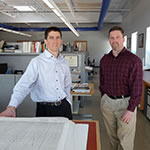gb&d: How do two brothers, almost a decade apart in age, both end up becoming architects?
Dave Roy: Our father was a builder in a local community in Barry, Vermont. We both grew up pounding nails and being on the work site. As I got into high school, I would do some of the drawings for houses my dad built. He’s a small contractor, but I would work directly with the owners even early on. We had high school drafting classes, and I think that’s where it took off.
Steve Roy: I’m not sure what else I would do! I would have to do something related to the construction industry—it’s my only interest.
gb&d: How about being brothers? Did Dave’s decision to be an architect shape your choices, Steve?
Dave: I don’t think I influenced him at all.
Steve: There was some, but who knows? Maybe I wouldn’t have been an architect, but I would have been something in the construction industry. We work together pretty well, but I think Dave is a better big-picture designer, and I like to dive into the detail a little more—
Dave: That’s the biggest understatement ever. He loves details, and I couldn’t get farther away from them.
Steve: It all makes sense since Dave is left-handed.
gb&d: How did sustainability become a prominent facet of your work?
Dave: Steve actually brought sustainability to the forefront of the office. I believe in it—it’s part of our philosophy, and we carry it through the firm—but Steve was at the forefront. [We’re] both LEED APs, and we’ve completed 11 LEED-certified projects and our office building is LEED Gold.
gb&d: Your firm as a whole is known for being green. What are some challenges you face in your day-to-day work?
Steve: Trying to push the developer and contractor mentality into the green movement. It’s a struggle to get somebody to look at a payback on anything that’s more than five to seven years.
gb&d: What projects are you currently working on?
Dave: We did our own net-zero homes, but there are projects ranging from police departments and fire stations to offices.
Steve: We recently completed the 802 Toyota Dealership. They have a 63-kilowatt-hour photovoltaic array on top that makes up most of their electricity. They also burn waste oil in a way that removes the waste product. For a commercial dealership to step up like that was great.
Dave: We’re also working on a new building for the Essex Police Department, which will allow it to grow and gather together all of its separate components under one roof. Currently the department has its main office wedged into a small building along with the Essex town offices while the police-records storage, detectives, training facilities, and vehicle storage is spread around town.
gb&d: Your firm takes part in the 2030 Global Challenge—how has this affected your work?
Steve: It makes you focus by giving you a framework to look at the amount of energy used and kind of look back on projects and see what was good and what could have been better.
Dave: There are certain benchmarks, in five-year increments, leading up to 2030. That keeps us looking ahead. It’s just a good way of building up.
gb&d: Looking at the future, what new sustainable ideas are you excited about?
Dave: My latest thing is trying geothermal.
Steve: I have an interest in getting Passive House certified, but demand is low within our office.


